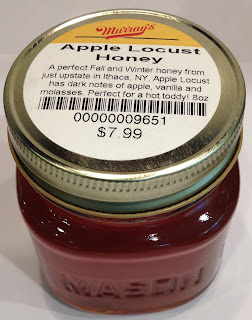- Packager: Apicolutra Cazzola, distributed in the United States by Forever Cheese, Inc. 36-36 33rd Street, Suite 307, Long Island, New York (718) 777-0772 www.forevercheese.com
- Nectar Origin: Emilia-Romagna, Italy
- Color: No color given. It looks light amber.
- US Grade: None.
- Filtration: Raw.
- Price: $22.19/pound.
- Flavor: This has a strong floral taste. I was expecting something cherry or berry like, but didn't experience that. It tastes almost like perfume.
Introduction
Introduction
In his monumental work, On Food and Cooking, Harold McGee writes, "[t]hough most honey is made from a mixture of nectars from different flowers, some 300 different 'monofloral' honeys are produced in the world . . ." Harold McGee, On Food and Cooking, page 663-64, Scribners, 2004. In 2012 I began a quest to try a few of these monofloral honeys. After a while I began looking for a book that would guide me in my quest and found nothing that met my demands. The reason for this was that I looked too soon. As far as I can tell, only in the summer of 2013 were two popular books published which cover this topic, The Honey Connoisseur by Marina Marchese and Ken Flottum and Taste of Honey by Marie Simmons. Not having had these books available, I took to the Internet -- that repository of all truth -- and found helpful information from the National Honey Board. On its website the Board provides a catalog of honey varietals that gives a good description of each floral source and sometimes a description of the honey's flavor. There is also a helpful brochure on varietals here. So, why isn't that the end of the story and the end of this blog?
One need only try a few of the many clover honeys available to discern that clover honey from one region tastes a bit different from clover honey from another region. There are regional differences in honey that make a noticeable difference. The Board's information is too general to take this fact into account. In addition, the Board doesn't review the honey of a particular supplier, as I intend to do. As for the books, they limit their discussion to 30 and 40 varietals, respectively, and I intend to go beyond that number. Another reason for soldiering on in this quixotic quest is that the Board's list is incomplete in some respects, as it readily admits. I suggest you consult both the Board and this blog when learning about a particular honey.
Accordingly, for the benefit of all mankind, I reluctantly take up the task of eating my way through as many honey varieties as possible and sharing some information about each variety. I hope you find something useful in what I write and return regularly as I slowly build this database. You see, I intend not to gain any weight in doing this project, so it will take years to complete. Spoons at the ready? Get set! Go!
A Note on Color
No, I am not color blind. I too can see that amber-colored honey is not white. Then why would I call any honey white? In the United States the US Government has classified honeys in seven categories: (1) water white, (2) extra white, (3) white, (4) extra light amber, (5) light amber, (6) amber and (7) dark amber. I have used this classification system because it appears on most labels. I might have used the Pfund honey grading system (which is in millimeters), but I don't want to pay for the equipment to take those measurements and you wouldn't care about those measurements if I had.
July 29, 2015
Cherry
July 28, 2015
Apple Locust Honey
- Packager: Murray's Cheese 254 Bleecker St., New York City, New York 10014 and also in Grand Central Station, New York City, New York (the latter is where I picked up my jar) (888) 692-4339 www.murrayscheese.com
- Nectar Origin: Ithaca, New York, USA
- Color: No color listed. I would way it is light amber.
- US Grade: None.
- Filtration: Raw.
- Price: $15.98/pound.
- Flavor: Is this a honeydew made from sweet secretions left by locusts on apple trees or is this honey from apple tree and black locust tree blossoms? I searched the Internet and the packager's website for some hint about what floral source this honey might come from and have come up empty-handed. I suspect that this is a honeydew because the black locust tree is not indigenous to New York, the stated geographical source of this honey. The lid says this honey has dark notes of apple, vanilla and molasses. I don't detect any apple flavor, but I can accept the vanilla claim. There is a slightly bitter aftertaste, maybe that is what accounts for the molasses description. You will have to try to figure this one out yourself. It has a complex flavor that is not easily described.

July 6, 2015
Orange Blossom
- Packager: Bee Chama Honey, 233 West Frontage Road, Polvadera, New Mexico 87828 USA www.beechamahoney.com
- Nectar Origin: Unknown. Presumably somewhere in the western United States.
- Color: In my unscientific estimation the color is Extra White.
- US Grade: Not Listed - It claims to be extra virgin, just like the olive oil.
- Filtration: Raw.
- Price: About $13.00/pound. (I bought a small bottle mislabeled as 12 ounces, it's probably about eight).
- Flavor: This has a great honey flavor with a small hint of orange at the end.

